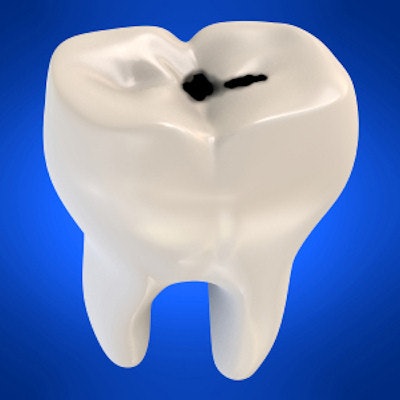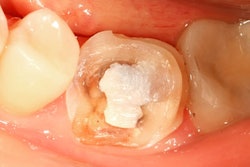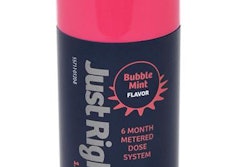
Potassium iodide (KI) improves the appearance of teeth treated with silver diamine fluoride (SDF), but does it reduce the effectiveness of SDF? Researchers reported mixed results in a March 23 presentation at the 2018 American Association of Dental Research (AADR) meeting in Fort Lauderdale, FL.
Investigators from the University of Washington School of Dentistry in Seattle reported in separate studies that adding KI to SDF treatment did not reduce its root dentin demineralization effects but did compromise its bonding to caries-affected dentin.
"Adding a supersaturated solution of potassium iodide can improve the aesthetics of SDF without affecting its ability to arrest caries," study author and dental student Vernon Zander told DrBicuspid.com in an email interview. "This needs to be studied further, especially in vivo, but at this time it seems that it can be a viable option to combat the dark stain of SDF."
“Adding a supersaturated solution of potassium iodide can improve the aesthetics of SDF without affecting its ability to arrest caries.”
Zander and colleagues used micro-CT (X5000, North Star Imaging) to examine bovine incisor root dentin blocks (3 x 4 x 3 mm3) embedded in resin that underwent one of four treatments:
- Deionized water (control)
- 5% sodium fluoride varnish (Duraflor, Medicom)
- 38% SDF (Saforide, Bee Brand Medico Dental)
- 38% SDF followed by KI (Sigma-Aldrich) saturated solution in deionized water
Before scanning, the researchers rinsed the dentin surfaces and subjected them to eight cycles of demineralization solution (pH 5) for 16 hours and remineralization in artificial saliva (pH 7) for eight hours.
They found that lesion depth was significantly greater in the control group than the other three groups, as was mineral loss (p < 0.05 for both). Fluoride varnish treatment yielded the smallest lesion depth and mineral loss, but the results were not significantly different from those in the SDF or SDF-KI groups. The authors also observed in SDF and SDF-KI micro-CT images a radiopaque dense surface layer that they attributed to silver penetration into the dentin surface.
They concluded that a single application of fluoride varnish, SDF, or SDF-KI demonstrated comparable preventive effects against root dentin demineralization and that the application of KI did not influence the antidemineralization properties of SDF.
"The results of this study would suggest the use of KI with SDF," Zander told DrBicuspid.com. "However, in order to affect the recommendations of the ADA, there would need to be more studies, especially those in vivo, to verify there are no negative outcomes to its use."
Aside from the fact that the aesthetics of SDF-KI are not as pleasing as those of some composites or other restorative materials, another drawback to SDF-KI is its lack of microtensile bond strength, Zander noted. This was demonstrated by another study presented at the AADR meeting by some of his University of Washington School of Dentistry colleagues. That study evaluated the microtensile bond strength of resin composite to caries-affected dentin treated with SDF or SDF-KI.
The researchers removed occlusal enamel of 30 caries-free extracted human molars to expose the flat dentin surface. After immersing the dentin in demineralizing solution, they rinsed it with deionizing water or treated it with SDF 38% (Advantage Arrest, Elevate Oral Care) or SDF followed by KI.
They bonded composite using Scotchbond Universal Adhesive (3M) in total etch mode over the dentin, and then cut microtensile bond strength beams from each specimen after 24 hours and tested them.
They found significantly different results between the groups (p < 0.005), with the highest values in the control group and the lowest in the SDF-KI group, which experienced frequent pretest failures.
| Microtensile bond strength of dentin | |||
| Control | SDF | SDF-KI | |
| Mean | 23.5 MPa | 19.8 MPa | 7.9 MPa |
| Range | 12.5-40.4 MPa | 8.1-33.8 MPa | 2.4-18.5 MPa |
"Due to the lack of bonding, clinicians need to be aware of the full treatment plan as direct bonding to surfaces treated with the addition of KI may be subjected to failure," Zander told DrBicuspid.com. "Another potential drawback is discoloration of dentin treated with SDF-KI in the long term."



















